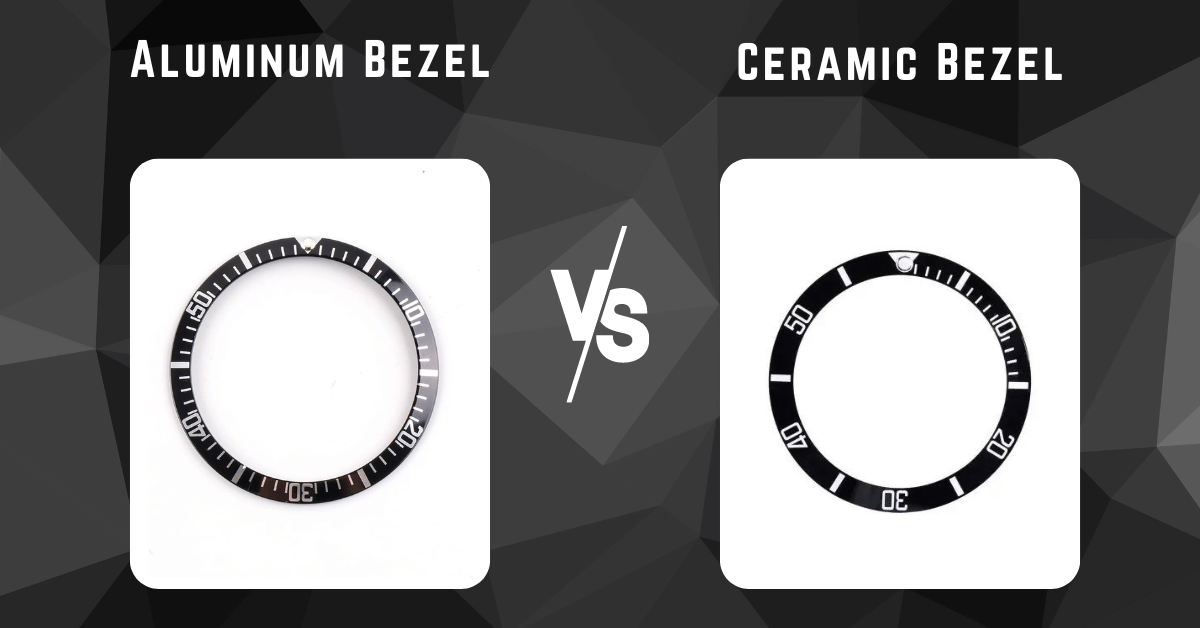In the realm of timekeeping, the bezel transcends mere aesthetics. It serves as a vital tool for divers, pilots, and anyone who needs to track elapsed time. But beyond functionality, the bezel material plays a significant role in a watch’s overall look, feel, and durability.
Two prominent contenders in this arena are aluminum and ceramic bezels, each boasting distinct advantages and disadvantages. This comprehensive guide delves into the intricacies of both materials, equipping you to make an informed decision when choosing your next timepiece.
Unveiling the Humble Aluminum: A Legacy of Affordability
Aluminum bezels have been a mainstay in the watch industry for decades, particularly in sports watches and tool watches. Their popularity stems from several key factors:
Affordability: Aluminum is a relatively inexpensive material, making it a cost-effective choice for manufacturers. This translates to more accessible price points for consumers.
Lightweight: The low weight of aluminum contributes to a comfortable wearing experience, especially for larger or more robust watches.
Versatility: Aluminum can be easily anodized in a wide range of vibrant colors, offering a vast array of aesthetic options to complement watch designs.
However, aluminum also comes with inherent drawbacks:
Scratch-Prone: Aluminum is a soft metal, susceptible to scratches and nicks from everyday wear and tear. These scratches can detract from the watch’s appearance over time.
Fading: Anodized aluminum can potentially fade with prolonged exposure to sunlight, especially for lighter colors. This can alter the aesthetic of the watch.
Limited Heat Resistance: While not a major concern for most wearers, aluminum can be susceptible to warping or deformation at extremely high temperatures.
The Rise of Ceramic: A Paragon of Strength
In recent years, ceramic bezels have emerged as a premium alternative to aluminum. Here’s what makes them stand out:
Exceptional Scratch Resistance: Ceramic is incredibly hard and virtually scratch-proof in everyday use. This ensures the bezel maintains its pristine look for years to come.
Colorfast: Unlike aluminum, ceramic bezels are resistant to fading, ensuring the vibrancy of the color remains consistent over time.
Heat and Corrosion Resistance: Ceramic exhibits exceptional resistance to heat and corrosion, making it ideal for watches intended for extreme environments.
However, ceramic also comes with a few limitations:
Higher Cost: Due to the complex manufacturing process and superior material properties, ceramic bezels typically translate to a higher price point for the watch.
Weight: Ceramic is a denser material than aluminum, potentially adding slight weight to the watch. This might be a factor for those who prioritize a lightweight-wearing experience.
Brittleness: While highly scratch-resistant, ceramic can be brittle. A hard impact at the right angle could potentially chip or even crack the bezel, requiring a more expensive replacement.
Choosing Your Champion: A Matter of Priorities
The ideal bezel material depends on your individual needs and preferences. Here’s a breakdown to guide your decision:
Choose Aluminum if:
- Affordability is a key concern.
- A lightweight and comfortable wearing experience is a priority.
- You appreciate the vast array of color options offered by anodized aluminum.
Choose Ceramic if:
- Superior scratch resistance and colorfastness are paramount.
- The watch is intended for extreme environments or potential exposure to high temperatures.
- You prioritize a premium aesthetic with a timeless look.
Remember: Both aluminum and ceramic bezels offer distinct advantages. Consider your lifestyle, budget, and the overall design of the watch when making your choice.
Beyond the Material: Additional Considerations
While the bezel material plays a significant role, other factors contribute to a watch’s overall functionality and aesthetics:
Case Material: The case material, such as stainless steel, titanium, or precious metals, complements the bezel and influences the watch’s weight and overall look.
Crystal: The type of crystal (sapphire, mineral glass) impacts scratch resistance and clarity.
Movement: The movement (automatic, quartz) determines the watch’s power source and level of complexity.
By considering all these aspects, you can choose a timepiece that perfectly aligns with your needs and preferences.
The Final Verdict: Your Ideal Timekeeping Companion
The battle between aluminum and ceramic bezels presents a compelling choice. Aluminum offers affordability, lightweight comfort, and a spectrum of colors. Ceramic boasts exceptional scratch resistance, colorfastness, and a premium aesthetic. Ultimately, the “best” material depends on your priorities.
Here are some additional thoughts to help solidify your decision:
The Watch’s Purpose: Consider the primary function of the watch. If it’s a daily wear watch, scratch resistance might be a higher priority. For a tool watch used in harsh environments, ceramic might be the more practical choice.
Aesthetics: Personal preference plays a big role. Do you gravitate towards a classic, vintage look often associated with aluminum bezels? Or do you prefer a modern, high-tech aesthetic often seen with ceramic?
Long-Term Value: Ceramic bezels generally retain their value better due to superior scratch resistance. If you plan to keep the watch for a long time, this might be a factor to consider.
Remember: There’s no single “correct” answer. The beauty of watches lies in their ability to express your personality. Explore different watches with both aluminum and ceramic bezels, try them on, and see which one resonates with you the most.
Beyond the Battlefield: Exploring Other Bezel Materials
While aluminum and ceramic are dominant players, other bezel materials exist:
Stainless Steel: Offers a classic, sophisticated look with good scratch resistance.
Sapphire Crystal: Provides exceptional scratch resistance but can be expensive and prone to shattering.
Tungsten Carbide: Extremely hard and scratch-resistant, but typically found on more specialized tool watches.
These options cater to specific needs and preferences, further expanding the realm of possibilities in the world of bezels.
The journey towards finding your ideal watch is part of the thrill. Embrace the exploration, delve deeper into the world of bezels and their materials, and ultimately, choose a timepiece that becomes a cherished companion on your path through time.

